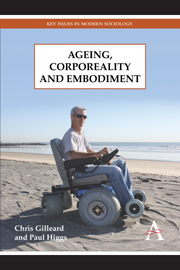Book contents
- Frontmatter
- Contents
- Introduction
- Chapter 1 Identity, Embodiment and the Somatic Turn in the Social Sciences
- Chapter 2 Corporeality, Embodiment and the ‘New Ageing’
- Chapter 3 Gender, Ageing and Embodiment
- Chapter 4 Age and the Racialised Body
- Chapter 5 Disability, Ageing and Identity
- Chapter 6 Sexuality, Ageing and Identity
- Chapter 7 Sex and Ageing
- Chapter 8 Cosmetics, Clothing and Fashionable Ageing
- Chapter 9 Fitness, Exercise and the Ageing Body
- Chapter 10 Ageing and Aspirational Medicine
- Conclusions: Ageing, Forever Embodied
- References
- Index
- ADVANCE PRAISE
Chapter 8 - Cosmetics, Clothing and Fashionable Ageing
Published online by Cambridge University Press: 05 July 2013
- Frontmatter
- Contents
- Introduction
- Chapter 1 Identity, Embodiment and the Somatic Turn in the Social Sciences
- Chapter 2 Corporeality, Embodiment and the ‘New Ageing’
- Chapter 3 Gender, Ageing and Embodiment
- Chapter 4 Age and the Racialised Body
- Chapter 5 Disability, Ageing and Identity
- Chapter 6 Sexuality, Ageing and Identity
- Chapter 7 Sex and Ageing
- Chapter 8 Cosmetics, Clothing and Fashionable Ageing
- Chapter 9 Fitness, Exercise and the Ageing Body
- Chapter 10 Ageing and Aspirational Medicine
- Conclusions: Ageing, Forever Embodied
- References
- Index
- ADVANCE PRAISE
Summary
Although the signs of a long life are inscribed on the body, it is through age not longevity that such signs are read. Wrinkles and grey hair provide the text that says a body is growing old. Whatever fortunes may or may not arise from living longer, most people prefer to avoid being read as ‘old’. The fear of looking old is every bit as great as the fear of being old and while the latter may be open to contestation, corporeal evidence of agedness seems to lie outside the authority of the self, turning the body into a text read by others through the dominant narratives of decline (Gullette 1997). While other visibly embodied identities such as disability, race and gender once lacked personal authority second modernity has undermined these narratives of marginality and otherness, and women, black, gay and disabled people have acquired new forms of embodied authority enabling them to attach to their bodies more valued sources of social and cultural distinction. Age has not yet achieved this resonance, despite the fact that these other, alternative voices are now finding themselves experiencing their own, distinctive ageing. It seems as if, for many among these new cohorts of people ‘ageing differently’, another strategy is being deployed, one that resists one's identity and lifestyle being overtaken by age.
- Type
- Chapter
- Information
- Ageing, Corporeality and Embodiment , pp. 115 - 130Publisher: Anthem PressPrint publication year: 2013

